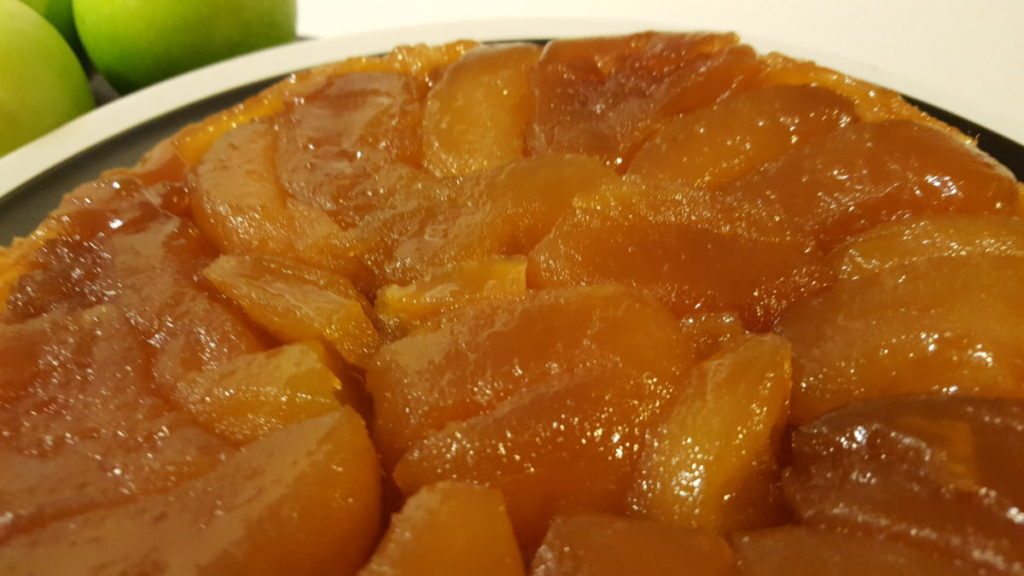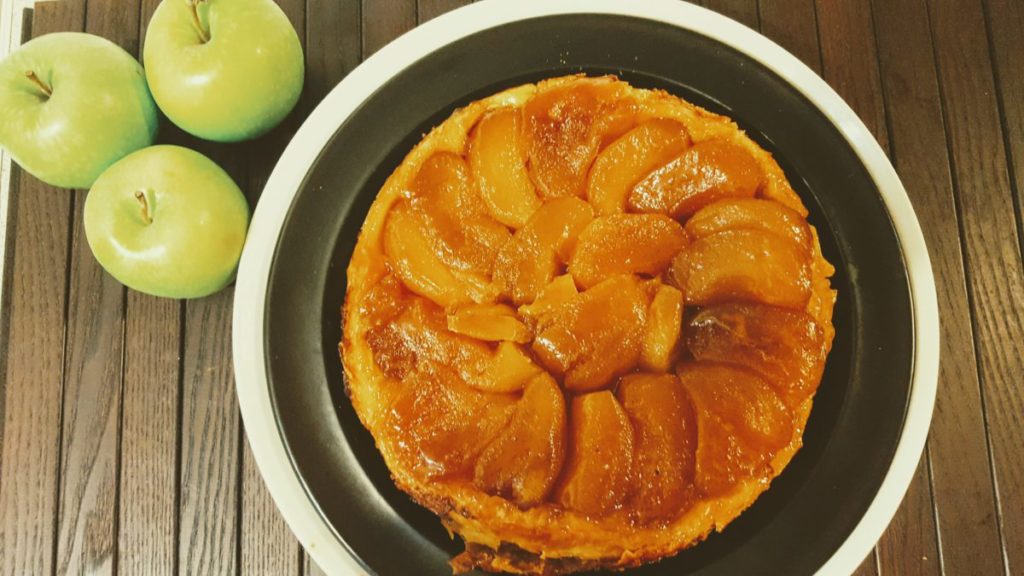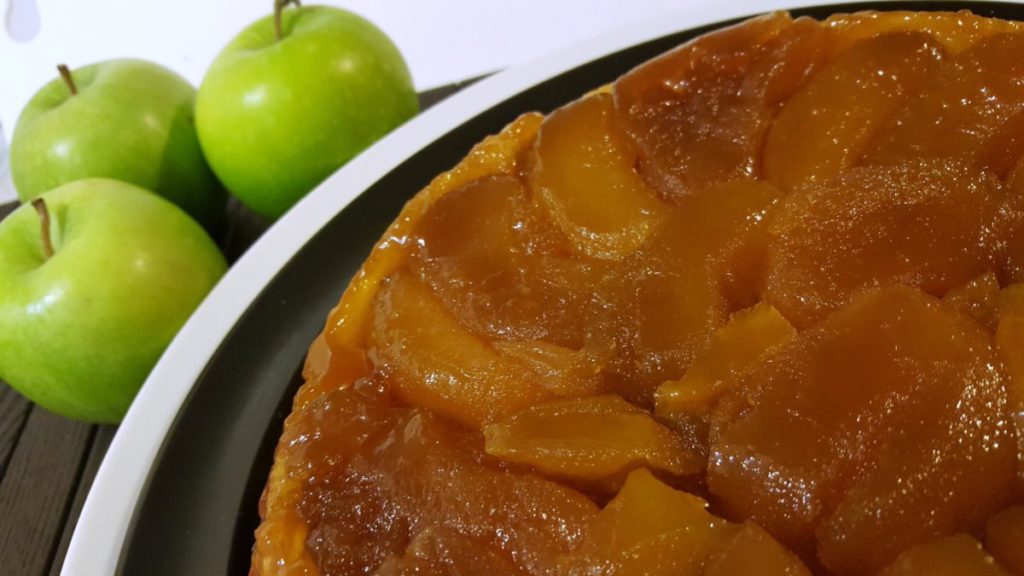Classic Tarte Tatin will never go out of fashion.
OK it’s not a dish for the calorie conscious, I give you that. But as an occasional treat, it’s hard to beat.
This famous apple tart was created by accident in the 1880’s by the elderly sisters Stéphanie and Caroline Tatin, who ran the Hotel Tatin in Lamotte-Beuvron south of Paris.
The most popular version of the story is that one day an overworked Stéphanie “Fanny” Tatin left the apples for her apple pie to caramelize in butter and sugar a little too long. In an attempt to rescue the situation and still have a dessert for her hotel guests that night, she quickly slapped some pastry on top to hide the mess, baked it and hoped for the best. It was a roaring success and became the signature dish of the Hotel Tatin.
True or not, I love this story, as it just goes to show that good things can come from what initially seems a complete disaster, both in the kitchen and no doubt outside it too.
Apparently the idea of an upside down apple tart had been done before though. Writings from 1841 suggest that the famous patissier Carème topped apples from Rouen with Parisien pastry. Today the tatin technique is applied to a multitude of fruit and even veg. Pears, pineapple, shallots, red onion, bananas, pears, carrots and beetroot all make for a delicious tarte tatin.
By now, so many chefs and cookery authors have written about how to create the ultimate apple tarte tatin, it may seem that a tatin must surely be confined to the territory of the professional kitchen.
The whole idea of making a caramel and then turning over the finished tarte with its hot sugary juices is a scary prospect for most home cooks. Fear not. It is actually fairly easy to make and only needs 4 basic ingredients: butter, sugar, apples and pastry.
I actually made the version in these pictures in the unfamiliar kitchen of a hi-de-hi-style holiday camp on an old electric hob with a very basic oven that lacked temperature and oven-mode indicators. So it was pure guesswork combined with a prayer as to whether this was actually going to work this time. It did.

There’s a couple of things to bear in mind when making a tarte tatin though:
The pan
Whatever vessel you use needs to be both flame proof on the hob and oven proof up to 190 C. This can be a dedicated tatin dish or a 5-6 cm high non-stick frying pan. If using a frying pan, make sure the handle does not go above the height of the pan or this will make for difficult turning at the end.
If you have something with two little handles, all the better for that turning over bit, as it will give you something to safely hold onto with both hands without the risk of the dish or the pan slip-sliding around.
You can buy tatin sets comprising a pan and a fitting flat serving dish for turning the tart out onto. Mine is a 21 cm one from Emile Henry (4-5 portions). Admittedly a luxury, but it does ease the process of making, baking and turning.
The diameter of your pan should be between 20-24 cm, depending on how many people you’re serving.
The sugar
This recipe calls for caster sugar rather than any of my beloved healthier sugar substitutes. Coconut palm sugar, erythritol, xylitol, stevia, honey and maple syrup all react differently in this particular cooking process. I have yet to find a way to make them work in a tatin without resulting in a tart that is too wet or a caramel that does not brown, browns too quickly or crystallizes.
You can use unrefined golden caster sugar, or even muscovado for an immediate extra caramel hit.
Add a little cinnamon or apple pie spice mix to the sugar for sprinkling over the apples before baking if you wish. I had a cinnamon-hater at the table, so I didn’t add any this time.
The butter
The clue is in the name: use butter. Not margarine or olive oil spread. Good, proper, real butter is what you need here. Sorry. Traditionally unsalted, but it’s great to use a slightly salted or even a fully salted version if you like salted caramel. If you use unsalted butter, you may even wish to add a pinch of salt to taste for the same effect.
The apples
Forget cooking apples. These apples need to hold their shape. Tarte tatin was originally made with either Reine des Renettes or Calville, but Golden Delicious, Fuji, Gala, Jonathan or Granny Smith are all good choices too. I always use Granny Smith, because I like their cooked texture and the way their acidity balances out the sweet caramel.
Most recipes call for the apples to be halved and then cored. Which is not an easy feat to do neatly. Go ahead if you’re a dab hand with a paring knife. Else I suggest you either core the apples with an apple corer before peeling or cutting them into quarters, then coring. Neither take much away from the final look of the tart. I used quarters for the tart in the pictures as I didn’t have an apple corer nor decent paring knife to hand in the basic hi-de-hi holiday camp chalet.
Use plenty of apples and make sure you pack them in tightly, as they shrink while baking. Many recipes tell you to place them cut side up. I like to pack mine upright, cut side against rounded side, as you can pack more of them in that way. Works fine if you’re using quartered wedges too.
It’s best to cook the apples a bit on the stove or in the oven before adding the pastry, as the apples take longer to cook than the pastry. 
The pastry
You can use puff pastry or shortcrust pastry. Feel free to make your own, but a good shop-bought pastry is OK for this. Even ready-rolled for ease, as long as the thickness is about 3-4 mm. Do read the label though, as some have weird ingredients in them that shouldn’t be there. You’re looking for a good all-butter pastry with ingredients you would use if you were making it at home.
My personal preference for an apple tatin is puff pastry. For shallot or beetroot versions, I often opt for shortcrust.
Chefs always make it look extremely easy to add the pastry. But for me that is the trickiest bit. The pan and the apples will be hot, so the moment the pastry touches them, it starts to melt a little before I can properly position it and tuck it in. The trick is to thoroughly chill the pastry. You may even want to put it in the freezer for a bit, not until it is solidly frozen and no longer malleable, but just so it is extra cold when you top the apples.
You can also let the partially cooked apples cool down a little before adding the pastry.
The plate
Make sure the plate you are turning the tart out onto is at least 4-5 cm larger than the cooking pan. This will allow for any hot sugary juices to safely escape without danger of spilling. Don’t choose a plate that is massively bigger though, as you won’t be able to grab hold of both the pan and the plate together to safely turn them over.
Turn the plate and the pan together quickly with one flick of the wrist. Don’t try and do it slowly and carefully, as it will end in tears.
The caramel
There are a few different options to make the caramel.
You can let the sugar slowly caramelize over medium heat (no stirring until it’s a golden amber or it will crystallize) and then let the butter melt into it. It’s OK to stir to combine at that stage.
Else you can cover the bottom of the pan with the butter, sprinkle over the sugar and let the caramel form with both together.
Alternatively, heat the sugar with the butter, stirring occasionally.
There’s a useful video guide on Meilleurduchef that shows the latter. It’s in French, but a good overall visual guide on how to make the caramel and then assemble, bake and turn a tatin even if you don’t understand French.
There are recipes out there that suggest putting the apples on top of the butter and sugar before caramelizing them. Don’t. I find that the juices from the apple prevent the caramel from ever properly forming and you’ll likely end up with a wetter tart.
I made my caramel with the first method (sugar first, then adding butter once the sugar was caramelized). The first attempt failed miserably (unfamiliar electric cooker…) : I couldn’t quite tell the temperature of the hob, panicked and started to stir the sugar a little too soon and then added the butter too soon too. It completely seized up, so went into the bin.
The second attempt was better, but still turned into a paste with some butter that hadn’t fully incorporated into the sugar, rather than the nice runny caramel of dreams. I sort of spread it out over the bottom of the pan best I could and prayed to the Tatin Gods. It worked just fine. So don’t panic if your caramel isn’t perfect before adding the apples.
With a bit of luck, all will be well. Just as it was for Stéphanie Tatin.
THE RECIPE
Classic Apple Tarte Tatin (for a 20-22 cm tarte, serves 4-5 DF V)
Ingredients
150 gr puff or short crust party
a little flour for rolling out
For the caramel:
70 gr unrefined (golden) caster sugar or light muscovado sugar
25 gr butter
For the filling:
5-7 firm tart apples, preferably Granny Smith (or 6-8 Williams pears)
30 gr butter, diced
80 gr unrefined (golden) caster sugar
a pinch of cinnamon or apple pie spice mix (optional)
Optional to serve: Clotted cream, creme fraiche or Creme Normande (see below)
Method
Heat the oven to 190 C.
Lightly flour the work surface and a rolling pin. Roll out the pastry to 3-4 mm thick and cut a circle that is 2-3 cm larger than the pan you will be making the tart in. Transfer to a large plate or a baking sheet lined with baking paper and a little flour. Chill until needed.
Put the sugar for the caramel into the tatin pan on the hob over medium heat. Allow it to caramelise to a golden amber. Don’t stir and don’t let it go too dark, or the caramel will be bitter. Remember this will cook further in the oven.
Turn off the heat and stir the butter for the caramel into the caramel. Set aside.
Peel and core the apples. Halve them or cut them into quarters. Arrange the apples tightly into the tatin pan on top of the caramel, cut side to rounded side.
Dot the apples with the diced butter and sprinkle over the cinnamon or pie spices (if using) and the remaining sugar.
Bake for 25 mins. Remove from the oven and set aside for 5 mins or so. Then top the apples loosely with the chilled pastry, gently tucking any excess pastry inside the pan. It does not need to look perfect and you’re not trying to get the pastry to stick to the pan. On the contrary.
Prick the pastry once or twice with a meat fork or sharp knife, or create a little funnel hole in the centre of the pastry to let any excess steam escape.

Return the tatin to the oven for 30 mins or until the pastry is golden and puffed up. Remove from the oven and let the tatin rest for 30-40 mins.
Place a flat serving dish upside down onto the tatin pan. Using oven gloves, grab hold of both the pan and the plate with both hands and quickly flick them over in one smooth motion.
Serve au naturel or with your cream of choice.

Creme Normande:
Whisk together 120 gr creme fraiche with 1-2 tbsp icing sugar, Xylotol or Erithritol and 1-2 tbsp calvados.






